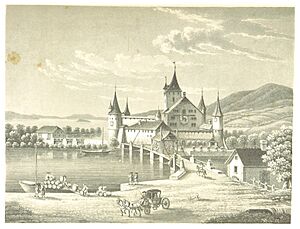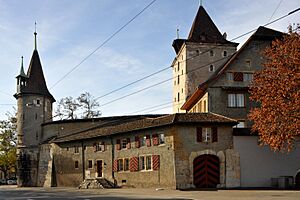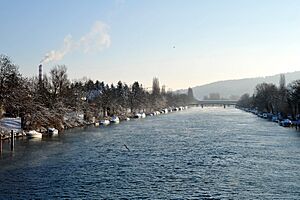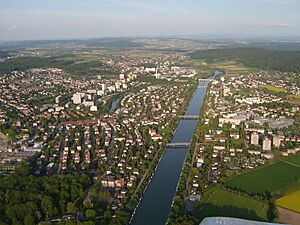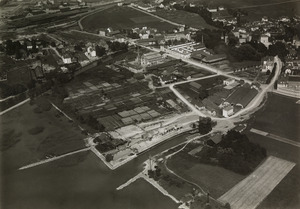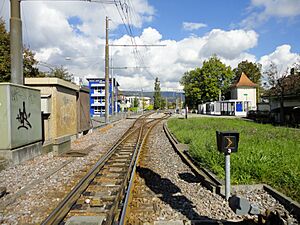Nidau facts for kids
Quick facts for kids
Nidau
|
||
|---|---|---|
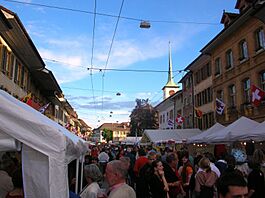
Stedtlifest Nidau
|
||
|
||
| Country | Switzerland | |
| Canton | Bern | |
| District | Biel/Bienne | |
| Area | ||
| • Total | 1.52 km2 (0.59 sq mi) | |
| Elevation | 432 m (1,417 ft) | |
| Population
(Dec 2020 )
|
||
| • Total | 6,943 | |
| • Density | 4,568/km2 (11,830/sq mi) | |
| Postal code |
2560
|
|
| Surrounded by | Biel/Bienne, Ipsach, Port, Tüscherz-Alfermée | |
| Twin towns | Schliengen (Germany) | |
Nidau is a town in Switzerland. It is located in the Biel/Bienne area of the Bern canton. Nidau is a municipality, which is like a local government area.
Contents
History of Nidau
Nidau was first mentioned in old writings in 1196. At that time, it was called Nidowe. Later, in 1352, it was recorded as Nydow.
Scientists have found signs of very old settlements in Nidau. These include stilt houses from the neolithic (New Stone Age) and late Bronze Age. These houses were built on stilts over water. An ancient tool from the La Tene culture was also found. Some iron pieces from the Roman era were discovered too.
A wooden castle was built here in 1140. Another one followed in 1180. Then, in the early 1200s, Nidau Castle was built using stone. The town grew south of this castle. It became bigger just before a battle in 1338. The town was shaped like a triangle, pointing towards the castle. It had a main street running north-south, parallel to the river.
The last count of Nidau, Rudolf IV, died in a battle in 1375. After him, the castle changed hands many times. It was owned by the Prince-Bishop of Basel and then the Counts of Kyburg. In 1379, the Habsburgs bought the castle and town.
During the Sempach War in 1388, forces from Bern and Solothurn attacked Nidau. They surrounded the town and castle for seven weeks. They finally took Nidau, but the castle was badly damaged. After the war, Bern was given the town and castle. Parts of the town were also damaged by fires in 1388, 1413, 1513, and 1743.
In 1425, Bern gave Nidau a special document that gave it certain rights. The town became an important place for trade. It was located on busy roads and near Lake Biel. People worked in markets, built ships, transported goods, and ran inns. Fishing, growing grapes (viticulture), and farming also provided food.
The town's church was first mentioned in 1368. It became its own parish church in 1482. In 1528, Nidau became Protestant during the Protestant Reformation.
In the 1700s and 1800s, Nidau often flooded. To stop this, the Jura water correction projects started in 1868. These projects lowered the water level of the river and lake. They also changed the river's path. The Nidau-Buren canal became the main waterway. Nidau also got a railroad connection to Biel/Bienne in 1857. This helped the two towns grow closer. Today, Nidau has many small and medium-sized businesses, mostly in services.
Geography of Nidau
Nidau is very close to the city of Biel/Bienne. The two cities have grown together. Because of the Jura water correction projects, the old part of Nidau is now on an island. This island is formed by the Nidau-Büren Aare canal, the Thielle river, and the shore of Lake Biel.
Nidau covers an area of about 1.5 square kilometers (0.58 square miles). Most of this land, about 84.2%, is used for buildings and roads. About 3.9% is covered by forests. The rest, about 11.8%, is made up of rivers or lakes.
The blazon (description) of Nidau's coat of arms is: "A red crayfish and a blue trout with red dots on a silver background."
People of Nidau (Demographics)
Nidau is located where German and French are spoken. The official language is German. However, many people in Nidau speak French. Children of French-speaking families can go to French schools in Biel/Bienne, and Nidau helps pay for this.
Nidau has a population of about 6,810 people (as of December 2011). About 20.8% of the people living in Nidau are foreign nationals. Most people (73.9%) speak German as their first language. French is the second most common (15.8%), and Italian is third (2.7%).
In 2011, about 18.2% of the population were children and teenagers (0–19 years old). Adults (20–64 years old) made up 58.6%, and seniors (over 64 years old) made up 23.2%.
The population of Nidau has changed over time:

Economy and Jobs
In 2011, Nidau had an unemployment rate of 3.28%. This means about 3 out of every 100 people looking for a job could not find one.
In 2008, there were 2,548 people working in Nidau. Most jobs were in the services sector (like shops, hotels, and healthcare). There were also many jobs in the manufacturing and construction sector.
Many people who live in Nidau travel to other towns for work. Also, many people from other towns come to Nidau to work. About 27.3% of workers use public transport, and 42.9% drive their own cars.
In 2011, the average tax rate for a married couple with two children in Nidau was 12.8%. For a single person, it was 18.8%.
Religion in Nidau
Based on a 2000 survey, about 53.5% of people in Nidau belonged to the Swiss Reformed Church (a type of Protestant church). About 22.1% were Roman Catholic.
Other religions included Orthodox Christians (1.4%), Christian Catholics (0.25%), and other Christian churches (2.47%). There were also people who were Jewish (0.24%) and Islamic (4.46%). A small number of people were Buddhist or Hindu. About 10.96% of the population said they had no religion, or were agnostic (not sure if God exists) or atheist (do not believe in God).
Education in Nidau
In Nidau, about 54.1% of adults have finished upper secondary education. This is schooling after primary and lower secondary. About 17.4% have gone on to higher education, like a university or a specialized college (Fachhochschule).
The school system in Bern canton starts with one year of optional Kindergarten. Then, there are six years of Primary school. After that, students go to three years of lower Secondary school. Here, students are grouped by their abilities. After lower Secondary, students can choose to continue school or start an apprenticeship (learning a trade on the job).
During the 2011–12 school year, 815 students attended schools in Nidau. There were 96 kindergarten students, 291 primary students, and 428 lower secondary students. Many students in Nidau's schools had a different first language than the classroom language.
Nidau has two libraries: the Bibliothèque de langue française and the Gemeindebibliothek Nidau. In 2008, these libraries had over 19,000 books and other media.
Transportation
Nidau has good public transport connections:
- Verkehrsbetriebe Biel (VB) (Biel Transport Company):
- Line 4 (trolleybus) connects Nidau to Biel/Löhr.
- Line 7 (bus) connects Biel/gold mine to Brügg.
- Line 8 (bus) connects Nidau to Port and Biel/fox Ried.
- PostBus Switzerland:
- Line 386 connects Biel to Aarberg.
- Line 387 connects Biel to Jens.
Art, Culture, and Sights
The most famous landmark in Nidau is Nidau Castle. Today, it holds government offices and a museum. The museum has interesting displays about the Jura water correction project.
The first wooden castle was built in 1140. A stone castle was built in the early 1200s. It was a square building with very thick walls and a tall main tower (about 40 meters or 130 feet). It also had three round towers and a wall around it. A moat (a ditch filled with water) and the Zihl river surrounded it.
After the Sempach War in 1388, Bern took control of the castle. For the next 400 years, it was the main office for the Nidau area. Over time, new parts were added to the castle, like a gatehouse in 1546 and a living area in the 1600s.
When the French invaded Switzerland in 1798, the old system changed. In 1803, Nidau Castle became the main office for the new Nidau district. The moat was filled in, and parts of the old wall were removed. After the Jura water correction projects in 1868, the water levels dropped, and the castle was no longer surrounded by water. The castle has been repaired and updated many times in the 20th century.
The Rathaus (Town council house), Nidau Castle, and the beach along Lake Biel (Strandbad Biel) are important Swiss heritage sites. The entire town of Nidau is also part of the Inventory of Swiss Heritage Sites.
Stedtlifescht
Every year, on the last Saturday in May, Nidau holds its Springtime festival called "Stedtlifescht Nidau." For this event, the main road through Nidau is closed to cars. Over 120 market stalls line the streets of the old town. Many visitors come from nearby Biel and the surrounding Seeland area to enjoy the festival.
Notable People from Nidau
- Friedrich Fiala (1817–1888), a bishop, was born in Nidau.
- Samuel Frisching (1605–1683), a leader of Bern, was also born in Nidau.
- Ulrich Ochsenbein (1811–1890), a Federal Minister.
- Georg Simon Ohm (1789–1854), a physicist, taught near Nidau.
- Eduard Müller (1848–1919), a Federal Minister.
- Hernan Ponce (1990–), a footballer (goalkeeper).
- Albert Trachsel (1863-1929), a Swiss painter, architect, and writer.
- Robert Roth (1898–1959), a Swiss wrestler who won a gold medal at the 1920 Summer Olympics.
International Connections
Nidau has a partnership with the German town of Schliengen in southern Baden-Württemberg. This is like a friendship between the two towns.
See also
 In Spanish: Nidau para niños
In Spanish: Nidau para niños





